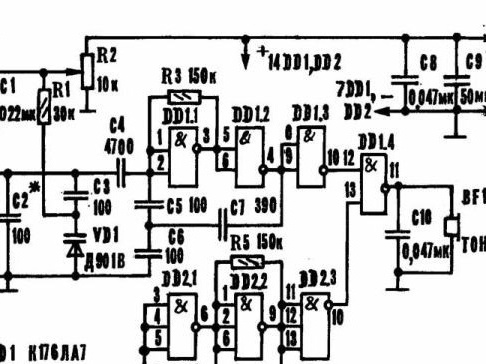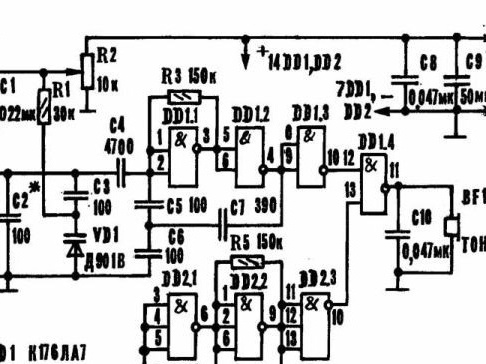
Schematic diagram and design description metal detector non-ferrous and precious metals, capable of detecting objects at a depth of 2 ... 3 m.
Among amateur radio designs, developments that help to detect metal objects hidden in the ground are of particular interest. Especially if the latter are small in size, occur at a considerable depth and, moreover, are not ferromagnets.
Mighty electrical circuits of such devices, called by analogy with the well-known military developments of metal detectors, and descriptions of fully functional designs have been published in various technical
publications, but they are often designed for trained, experienced craftsmen with a good material base and scarce details.
But the design we are offering will be able to repeat-make even a beginner. Moreover, the necessary details (including a 1 MHz quartz resonator) will be completely affordable. Well, the sensitivity of the assembled metal detector ... It can be judged even by the fact that with the help of the proposed device it is easy to find, for example, a copper coin with a diameter of 20 mm and a thickness of 1.5 mm at a depth of 0.9 m.
Operating principle
It is based on a comparison of two frequencies. One of them is the reference, and the other is variable. Moreover, its deviations depend on the appearance in the field of a highly sensitive search coil of metal objects. For modern metal detectors, which can be quite justifiably attributed to the design under consideration, the reference generator operates at a frequency that is an order of magnitude different from that that appears in the search coil field. In our case, the reference generator (see the circuit diagram) is implemented on two logical elements AND NOT integral DD2. Its frequency is stabilized and is determined by the quartz resonator ZQ1 (1 MHz). The generator with a varying frequency is made on the first two elements of the IS DD1.The oscillating circuit here is formed by a search coil L1, capacitors C2 and C3, as well as a varicap VD1. And for tuning to a frequency of 100 kHz, use potentiometer R2, which sets the required voltage for the varicap VD1.

As buffer amplifiers of the signal, logic elements DD1.3 and DD2.3 are used, working on the mixer DD1.4. The indicator is the high-resistance telephone capsule BF1. A capacitor C10 is used as a shunt for the high-frequency component coming from the mixer.
The circuit board configuration is shown in the corresponding illustration. And the arrangement of the radio elements on the side opposite to the printed conductors is given here in a different color.

Fig. 2. Circuit board homemade metal detector, indicating the location of the elements.
The metal detector is powered by a 9 V DC source. And since high stabilization is not necessary here, a Krona battery is used. Capacitors C8 and C9 successfully work as a filter.
The search coil requires special accuracy and attention in the manufacture. It is wound on a vinyl tube with an external diameter of 15 mm and an internal diameter of 10 mm, bent in a circle shape of 0,200 mm. The coil contains 100 turns of wire PEV-0.27. When the winding is done, it is wrapped in aluminum foil to create an electrostatic screen (to reduce the influence of capacitance between the coil and the ground). It is important to prevent electrical contact between the winding wire and the sharp edges of the foil. In particular, oblique wrap will help here. And to protect the aluminum coating itself from mechanical damage, the coil is additionally wrapped with an insulating bandage tape.
The diameter of the coil may be different. But the smaller it is, the sensitivity of the entire device becomes higher, but the search area for hidden metal objects narrows. As the diameter of the coil increases, the opposite effect is observed.
Work with a metal detector as follows. Having located the search coil in close proximity to the earth's surface, adjust the generator with potentiometer R2. And so that the sound is not heard in the telephone capsule. When the coil moves above the surface of the earth (almost close to the last), the cherished place is found - by the appearance of sound in the telephone capsule.
